The Mass-Media Madhouse
(Press-Central For Handy Soundbites, Useful Info,
And A Good Wet-Your-Pants Laugh)
Home / The Mass-Media Madhouse
(Press-Central For Handy Soundbites, Useful Info,
And A Good Wet-Your-Pants Laugh) / A Haphazard Miscellany Of Book And Blog Contributions
A Haphazard Miscellany Of Book And Blog Contributions
I’m not sure if I’m infinitely quotable or just that special kind of crazy that folks find entertaining — but for some reason, non-fiction authors love to include my point of view in their books. (Maybe it makes whatever they’re saying seem more rational and credible, by comparison. If so, I’m glad I could help.) They’re especially fond of tossing me in with a bunch of other “experts” — so they can (I’m convinced) show how far left of center my opinions from those of my cohorts. You know what I say to that? Bring it on!
I’ve contributed commentary about getting organized, simplifying life, child-freedom, full-timing, travel, entrepreneurship, creativity — you name it, I’ve got something to say about it. Here are my favorite bits of media stardom — and hey, if you need any snark-laden quotes for your next publication, gimme a holler.
Smead Room-By-Room Organization For The Home
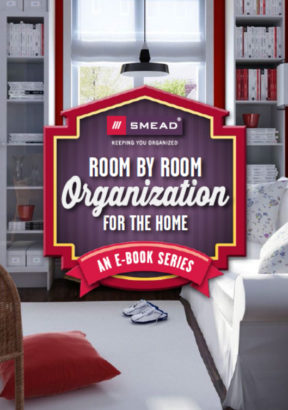 In addition to the 83,000 articles I’ve written for Smead’s website (and the interviews I’ve done for their podcast), I also contributed to their published compendium of household organization tips. As with my hands-on clients, we start with a look at what “clutter” really means:
In addition to the 83,000 articles I’ve written for Smead’s website (and the interviews I’ve done for their podcast), I also contributed to their published compendium of household organization tips. As with my hands-on clients, we start with a look at what “clutter” really means:
“I always ask my clients to tell me their definition of clutter before we begin working — it’s only when you have a clear idea of what clutter looks like that you can weed it out. My definition is ‘Anything extraneous or unnecessary that takes up a valuable resource (like time, space, energy, or money) without noticeably improving your quality of life in return.'”
Which naturally lead to a discussion of clutter control techniques:
“Clutter occurs when more comes in than goes out, so a good organizing system helps you set limits on new acquisitions. An example is the ‘one-in-one-out rule’ — every time you buy a new pair of pants or subscribe to a new newsletter or get a new bank statement, an old one goes away. Another is setting a numerical/spatial boundary on how many of a certain item you’ll own — like you’ll only allow yourself as many ceramic frogs as will fit on this display shelf, or ten pairs of shoes, or a year’s worth of old e-mails.”
Then a bit about the art of conscious decision-making:
“Decluttering is all about being able to draw boundaries — choosing to include only those things (including information, activities, and people) provide you with value and serve a purpose in your life, and letting go of those that don’t. The moment you start making conscious decisions about how you use your space/time/energy, you’ll instantly find yourself clearing the decks.”
A principle-driven look at all those generic organizing tools and techniques:
“It can be hard to utilize universal organizing tips in a way that solves more complicated real-life challenges. The problem with generic technique is that everyone has a different style of working and organizing. If you first figure out your style, you will have a better idea about the systems and strategies that will best suit your predilections.”
Finally, organizing as a lifestyle, rather than a destination:
“Decluttering is not a one-time activity, it’s an ongoing process. Think of it like exercising or brushing your teeth — you can’t do it once and be done. It takes regular maintenance to keep clutter at bay.”
The Experts’ Guide To Managing Your Time
 I concocted an entire chapter about “not-to-dos” for this bad boy. First, a look at those tasks you shouldn’t even be worrying about:
I concocted an entire chapter about “not-to-dos” for this bad boy. First, a look at those tasks you shouldn’t even be worrying about:
“It is incredibly difficult for people to admit that they can’t do everything themselves. Well guess what — you can’t! And I don’t know that you would want to, even if you had the time. Some activities are unenjoyable or outside of your range of expertise. There is nothing wrong with admitting that you don’t want to do something, as long as you can find someone else to do it for you. That is the purpose behind creating a not-to-do list — helping you identify chores, errands, and daily responsibilities that you can (and should) delegate to another person.”
A few tips for your “screw-that-I’ve-got-much-better-things-to-do” list:
“They key to creating a successful ‘not-to-do’ list is awareness — paying attention to what you do, how long it takes, how often you do it, and whether or not you get some benefit from that particular activity. However, we spend so much of our days on autopilot and in a state of overload, that simply trying to recall how you spent yesterday morning can be a real challenge! You will make things much easier if you keep a notepad nearby. This doesn’t mean logging every second of your day. (I don’t think ‘8:05 to 8:10 — used bathroom’ or ‘8:15 to 8:45 — had breakfast’ is going to help you be more efficient!) But tracking your daily activities will help you see places where you can trim and tighten your schedule through delegation.”
Moving on to a discussion of how much your time is worth:
“When you were a kid, you probably had no clue what it took to earn money — and you had no qualms about spending it freely on anything that caught your eye. But when you got an after-school job or started working for your allowance, you became a lot more discriminating about where you spent your hard-earned cash. It’s the same with time. Very few people in our society really know what their time is worth — in concrete financial terms. But until you recognize that your time is intrinsically valuable, you will never be able to make informed decisions about where your time is best spent.”
And costs versus benefits on low-payoff activities:
“If I pay someone $25 an hour to take care of a not-to-do item (when my hour is worth $95) — I’m coming out ahead. The same is true when I hire someone to do a task in a half hour that would take me three to complete. I can focus on higher priorities — things that feed my soul or grow my business or let me know I’m alive. Look for low-payoff activities, the kinds of tasks that you procrastinate on because they’re time-consuming and not especially rewarding — but if left undone they can erode away at your home, your career, your health, your peace of mind, and cause serious problems down the road. These chores are perfect candidates for your ‘not-to-do’ list — items that need to be done, but not necessarily by YOU.”
And an examination of a far-more esoteric issue when it comes to delegation:
“Of course, you have to pay attention to more than just the financial cost of each task — you also have to ask if you really enjoy the work. For example, my sister loves playing in the dirt. She finds it incredibly relaxing and would never pay for a lawn service. Now for me, yard work is pretty much my idea of hell — I would pay a gardener in a heartbeat and spend that time working on my website. It’s all a matter of what energizes you, what fills your life with joy, and what you look forward to doing. If an activity fits this description, keep it for yourself and find other less pleasurable chores to include on your not-to-do list.”
Finally, figuring out where you’ll get the biggest long-term bang for your buck:
“The final question I ask clients is, ‘What is the best possible use of your time at this exact moment?’ We tend to focus too much on the daily grind (paying bills, keeping the house clean, writing reports) and too little on our real priorities. Do you really need to be organizing the garage, or spending time with your kids at the park? Is it more important that you arrange chairs for the upcoming sales meeting, or work on the report you’ll be presenting? Ask yourself where you will get the biggest bang for your buck. That should be where you focus your attention, and let someone else handle the rest.”
Million Dollar Time Management
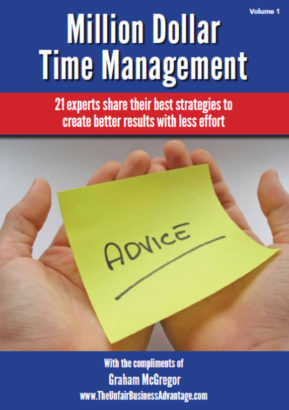 Another publication where I was given free reign to jabber away for a whole chapter! I started with a general discussion of boundary-drawing:
Another publication where I was given free reign to jabber away for a whole chapter! I started with a general discussion of boundary-drawing:
“Tell me if this sounds familiar. You get asked to do something you really don’t want to do (or honestly don’t have time for) — picking up the slack for a colleague, participating on a committee, or even just working late. You want to decline, but you worry about letting the other person down. So you agree — even though doing so puts you under tremendous stress and pressure. You know you’ll end up resenting this activity (and maybe even ducking some of your responsibilities) because your heart’s not in it. You also stand a good chance of disappointing the other person, but you go ahead and commit anyway. How is that good time management?”
An examination of our reluctance to use the “n-word” with folks:
“Why are we so afraid to tell people ‘no?’ When did we adopt this entirely false and self-defeating idea that turning down a request is disrespectful? We seem to value other people’s time more than our own — feeling that must bend over backward to accommodate their needs, even if it inconveniences us. Let’s be reasonable! ‘No’ is actually one of the healthiest words that can come out of your mouth. When you tell someone ‘no,’ what you’re really saying is that you understand and accept your own limits — and don’t want to do a shoddy job by overwhelming yourself. You’re making it clear that you value your time and priorities, and aren’t willing to short-change the truly important things in your life. A little selfishness is necessary, if you want to maintain a balanced and sane existence on this planet!”
And how to turn folks down without making them feel they’ve been turned down:
“So how do you grow a spine and learn to say ‘no’ without insulting the other person, being consumed by guilt, or hurting your own credibility? You need to find a way to decline a request without dragging up all of those hidden fears that constantly nibble at the back of your mind — they’ll think I’m lazy or selfish, that I have no career drive, that I’m not ambitious, that I have no concern for other people. This requires a major shift in your attitude. If you approach a challenging situation with the recognition that you’re doing what’s best for everyone involved (not just yourself), most of this unnecessary baggage will go away. Once you’ve accepted that you do actually have the right (and often the responsibility) to turn someone down, you can confront the person in an assertive yet respectful way that doesn’t seem like a rejection.”
And finally, a list of suggestions for phrasing your declination:
- “Not right now, but I could help out later.” (If you can’t drop everything right this second, offer a specific time or date — giving them the option to seek other assistance if they can’t wait for you.)
- “This isn’t my strong suit.” (Knowing what you can handle and what you can’t is a tremendous talent — if you don’t have adequate skills to take on a task, it’s better to admit your limitations up front.)
- “I don’t have any room in my calendar right now.” (Be honest if your schedule is filled — and filled doesn’t have to mean FULL, it just means you’ve scheduled as much as you’re willing to take on.)
- “I can’t, but I know someone who can.” (If you aren’t available, offer another resource — professionals refer clients to colleagues all the time, so why not use the same technique internally?)
- “I have another commitment.” (It doesn’t matter whether that commitment is a meeting or a dentist appointment or a day in the park with your kid – you aren’t available.)
- “I’m in the middle of several projects, and I hate to split my attention.” (Let people know that you want can’t do a good job when your focus is too divided or splintered.)
- “I’ve had a few things come up, and I need to deal with those first.” (When the unexpected throws off your schedule, you may need to cut back until your life stabilizes again.)
- “I would rather decline than end up doing a mediocre job.” (Knowing that you aren’t able to deliver a quality product, for whatever reason, is reason enough for turning a request down.)
- “I don’t enjoy that kind of work, but I’m happy to help with another task.” (If someone tries to dump a job you really despise on your shoulders, offer to do something you find more stimulating.)
- “I’m not comfortable with that.” (You might feel a little leery of the people involved, the type of work, the moral implications — this is a very respectful way to avoid a sticky situation.)
- “I’m leaving time for myself in my schedule.” (You ARE allowed to have a private life, so treat your personal time like any other appointment — block it off in your calendar and guard it like Fort Knox!)
- “I know you’ll do a wonderful job on your own.” (Folks often ask for help because of self-doubt — show some confidence in the other person’s ability to succeed without you.)
Rent-A-Lorry — Number One Moving Tip
 This truck-rental company in SINGAPORE (you can’t make this stuff up) contacted me and 21 of my colleagues for our best moving tips — the end result is one of the more comprehensive relocation guides on the web. Of course I was all about planning ahead — step one is whole-house layout:
This truck-rental company in SINGAPORE (you can’t make this stuff up) contacted me and 21 of my colleagues for our best moving tips — the end result is one of the more comprehensive relocation guides on the web. Of course I was all about planning ahead — step one is whole-house layout:
“Plan your new space (as best you can) before you get there — before you even pack the old house up! One of the worst mistakes that people make during a move is waiting until they unpack to decide where everything should go. Chances are, you will have some at least some basic sense of the layout of your new home before you ever load the first piece of furniture on the truck. Ask for a scale model floor plan (on new construction) or walk around and take measurements of each room (if you’re buying a pre-owned home).”
Step two involves plotting out each individual room in detail, so you know exactly what goes where:
“Then, decide what purpose each room will serve (master bedroom, kid’s room, den, play area) and where each piece of furniture will fit best. Cut out paper rectangles, squares, and circles to represent each chair, sofa, and table — all you have to do is lay your cutouts on your floor plan to get some sense of how each room will work. This doesn’t mean that you won’t suddenly get a hankering to move that desk to the other side of the room when you reach your destination, it just gives you a place to start.”
Step three — color-coding your stuff:
“Once you have a basic plan in mind, assign each room a color — blue for the bedroom, green for the bath, red for the kitchen, purple for the living room, whatever. This color scheme will follow you throughout your move. As you fill a box with dishes, mark it with a sharpie (not a sticker that might fall off) that says ‘Kitchen — Dishes.’ When you pack up your towels, use a green marker to label the box ‘Bathroom — Towels.’ As you wrap up your sofa, place a purple piece of paper that says ‘Living Room — Sofa’ under the clear plastic so you can see it. Then, draw out the floor plan for each room on a matching-colored piece of construction paper.”
And step four, making it easy for even stupid people to unload the truck correctly:
“Then when you arrive at your new home, take a minute to tape the correct floor plan on the door of each room. And put a color-coded master floor plan of the entire house on the front door — showing which color you have assigned each room. Now all you have to do is instruct your movers (or friends or helpers) to match the color on the box or the piece of furniture to the floor plan. They will even know where to put each item once they get to the appropriate room. No more having to field the question, ‘Where does this go?'”
The FabJob Guide To Becoming A Professional Organizer
These folks put together all sorts of career guides for self-employment — and they asked me to contribute to their manual for organizers. We started with a discussion of what purpose the consultation serves:
“When I do a consultation, I say to the client, ‘Tell me what you need, tell me where the pain is, and tell me what I can do to help improve this situation.’ And then we start talking about steps to take.”
Which almost immediately led to the 64 million dollar question:
“I recommend that new organizers offer a free consultation. It gives you the opportunity for a ‘face-to-face’ where you can start building rapport. It also allows you to see a client’s ‘mess’ and begin formulating a plan.”
Then an examination of how to prepare for an upcoming appointment:
“New organizers need to plan ahead so they can enter each appointment ready to hit the ground running. Ask yourself, ‘What kind of stuff do I expect to see? And what sorts of categories will make the most sense based on what I know about this client?’ Of course you’ll tweak/adjust this plan when you’re on-site with the client — but at least it gives you a basis for action.”
And they graciously allowed me to promote my business training program:
“I’ve developed a comprehensive training program, designed to help newbie entrepreneurs get their businesses off the ground faster from the very beginning. Each course is in PDF format (with a variety of supplemental tools, templates, audio/video recordings, and coaching support options) — so students can learn at their own pace, at their own leisure.”
No Problem — The Upside Of Saying No
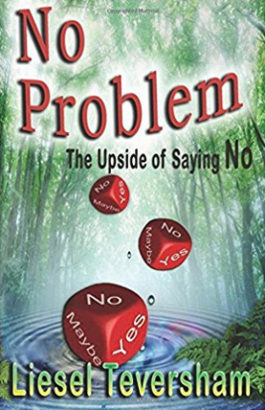 Until this book came out, I had no idea my ‘ways to say no’ was an “emotional freedom modality” — you learn something new every day:
Until this book came out, I had no idea my ‘ways to say no’ was an “emotional freedom modality” — you learn something new every day:
Here are a few ways to say “no” guilt-free from professional organizer Ramona Creel. You might feel uncomfortable with some of these — find the ones that are most comfortable and begin to practice with them. The majority of new skills feel unnatural and stretch us in the beginning. Babies fail down hundreds, if not thousands of times, before they walk well:
- “I need a day or two to check my schedule and get back to you.” (Take the pressure off to prevent going into automatic “yes” mode — then from a quiet, calm, unpressured place, you can make a better decision when you’ve had time to consider all your options.)
- “I’m really focusing more on my family/personal projects/career right now.” (Your values are yours and ours alone to decide.)
- “That’s not something I really wan to do.” (If you don’t enjoy something, why do it? Life doesn’t have to be about drudgery — and you have the right to look forward to tasks rather than dreading them.)
- “From past experience, I know that this really isn’t my strength.” (Admitting this makes you both stronger and more human at the same time. People respect you for knowing what you can handle and what you can’t — you may find more requests to help out with tasks you really love and fewer that you don’t once you start communicating this.)
- “I don’t have any experience with that.” (Volunteering to help out shouldn’t mean that you have to learn an entirely new set of skills. Offer to assist with something you already know how to do.)
- “That doesn’t work for me.” (We tend to want to provide reasons — but it really isn’t anyone else’s business what’s going on in your life. It’s your prerogative to say no. End of discussion.)
Then a little summation about how these responses shake out:
“You may have noticed that most of these fall into four different categories — buy yourself some time, offer another option, acknowledge your limitations, self-care.”
I also contributed to her ‘Bill Of Assertive Rights:’
- You have the right to do what you want — without explaining or justifying your behavior.
- You have the right to ‘me’ time — without asking for permission or forgiveness.
- You have the right to ask for what you want — and expect that request to be honored.
- You have the right to be heard — and taken seriously.
- You have the right to ask for more time — regardless of what you’ve already agreed to.
- You have the right to refuse to take on other people’s problems — no matter who those people are.
- You have the right to change your mind — as many times as you want.
- You have the right to make mistakes — as long as you acknowledge and own them.
- You have the right to say ‘I don’t know,’ ‘I don’t understand’ — and even ‘1 don’t care.’
- You have the right to say ‘no’ — without feeling guilty.
Organizing Plain And Simple
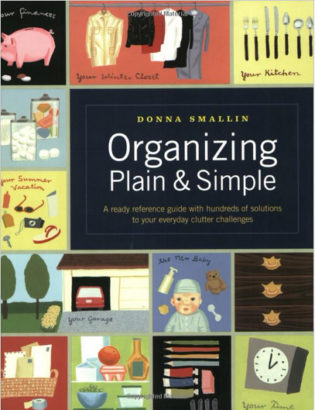 This insanely-comprehensive guide to organizing pretty much everything in your life includes three of my tips — the first about setting time-limits on your stuff:
This insanely-comprehensive guide to organizing pretty much everything in your life includes three of my tips — the first about setting time-limits on your stuff:
“If you haven’t touched something in the part twelve months. chances are that you’re not going to use it in the next twelve. (Clothes and sporting goods seem to be some of the worst offenders.) It’s natural for people to have a hard time letting go of the past. If an old outfit or a bowling ball really means that much to you, then put it away with your keepsakes — if you feel like you need to hang on to ancient financial paperwork, put it In a remote storage area. Just don’t take up valuable space in your active storage areas with items you don’t use.”
Moving on to the fine art of, well, art supply storage:
“Stackable clear plastic tubs with lids are great for storing crafts items. They come in so many different sizes, you’re guaranteed to find a container that’s just right for your particular supplies. Try to keep like items together — for example, pom-poms in one tub and all glues in another. And use resealable plastic bags within tubs to separate different sizes or types of the same item — such as small googly eyes versus large ones, or plastic beads versus wooden ones. Label your containers and stack them neatly on a shelf.
Plus a practical step toward a more harmonious family calendar:
“I suggest setting aside time once a week for a household planning session at which everyone can discuss their upcoming activities, appointments, events, and things to do. Record everything on your family calendar. Just taking time to discuss plans and make sure they gel with everyone else’s plans is a huge step toward getting better organized.”
Selfication — How to Simplify And Organize Your Life
 Selfication is the process of closing the gap between who you are and who you want to be — breaking down the science of human flourishing into simple, actionable steps so that you can use them to become the highly effective and healthy person you want to be. I was recruited to contribute my own take on the practical logistics of simple living — beginning with identifying and defining your complications:
Selfication is the process of closing the gap between who you are and who you want to be — breaking down the science of human flourishing into simple, actionable steps so that you can use them to become the highly effective and healthy person you want to be. I was recruited to contribute my own take on the practical logistics of simple living — beginning with identifying and defining your complications:
“You can’t make a resolution to ‘simplify’ until you know what currently feels too ‘complicated’ — so let’s start by getting clear about your definition of living simply. Take a minute to look back over the past year at all the things you’ve been tolerating and would like LESS of in your life — like clutter, stress, debt, too many obligations, rush hour traffic, working on the weekends, or toxic relationships.”
The next step is to envision exactly what your ideal life to will look and feel like when you achieve it:
“Then think about all the things that help you to feel grounded and centered, that you’d like to have MORE of in your life — like free time, satisfying work projects, regular exercise and good nutrition, a sustainable living environment, or opportunities to express your creativity.”
Finally, formulate a plan for turning that vision into a series of practical life changes:
“Now, set a specific goal related to each of these issues — for decluttering your closets or reducing your monthly expenses or drawing healthier boundaries at work or whatever is going to bring your life back into alignment with your values. Even small changes can make a big difference, so start with those — then you’re welcome to work your way up to more radical ways of simplifying.”
Sync Or Swim
 This book looks at what it means to be out of sync — when your life is so overwhelmed, you can’t keep up. Based on “decades of experience with drowning clients,” it’s filled with tips from organizers like me who “work daily on the front lines of disorganization and stress.” (No hyperbole there, thank goodness. Otherwise, I’d’ve had to turn the authors down.)
This book looks at what it means to be out of sync — when your life is so overwhelmed, you can’t keep up. Based on “decades of experience with drowning clients,” it’s filled with tips from organizers like me who “work daily on the front lines of disorganization and stress.” (No hyperbole there, thank goodness. Otherwise, I’d’ve had to turn the authors down.)
Each chapter was given a watery theme (which is why my section talks about a “constant STREAM of activities and obligations” — as well as “keeping your house and the stuff it contains SHIPSHAPE”). Authors Allison and Judith claim to have consulted with the best advisors on home maintenance, family management, and residential organizing for their best “new school” tips for controlling clutter, coordinating calendars, managing school materials, meal prep, shopping, and housekeeping.
My stunningly brilliant contribution (typed with sarcasm dripping from my keyboard) is tip #108.
“Create a standard grocery shopping checklist on your computer, listing foods you buy regularly, organized according to the section of the store (produce, dairy, canned goods, frozen). Print extra copies and stick one to the fridge. Whenever you run out of an item (or have a craving for a particular snack), circle it on the list, and you won’t find yourself forgetting half the things you needed when you go shopping!”
The Other Side Of Organized — Clutter Management Tips
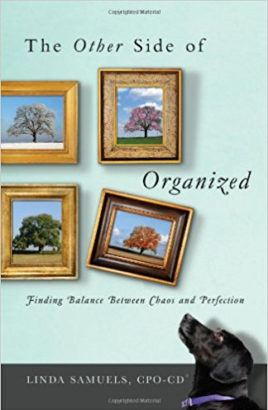 I and eight of my colleagues were each asked for our favorite clutter-busting strategies — specifically, ones that were creative, practical, and doable. As per usual, I had to talk basic acquisitional/consciousness principles first:
I and eight of my colleagues were each asked for our favorite clutter-busting strategies — specifically, ones that were creative, practical, and doable. As per usual, I had to talk basic acquisitional/consciousness principles first:
“Clutter creeps up on you and takes over your space when you aren’t paying attention to your stuff — so the trick to taming the mess is to pay better (and more frequent) attention to what you’re accumulating and why.”
Before launching into my suggestions for tackling the stacks and piles:
“Every time you walk through a room and see something out of place, take a second to put it where it belongs. And if that item no longer seems to serve a purpose in your life, drop it in the ‘to donate,’ ‘to sell,’ ‘to give away’ (or otherwise ‘to get rid of’) bin – rather than sticking it back into storage.”
Organizing And Customizing With Microsoft Outlook
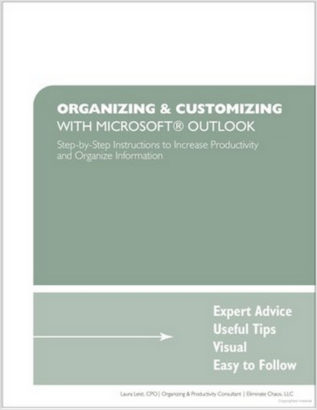 Okay — this one unreasonably amused me. When the author asked for my best e-mail decluttering tips, I talked about using filtering to sort incoming messages into meaningful categories for easy processing:
Okay — this one unreasonably amused me. When the author asked for my best e-mail decluttering tips, I talked about using filtering to sort incoming messages into meaningful categories for easy processing:
“Using your inbox as an e-mail catch-all is no different than keeping a lot of papers on different subjects stacked in box. The most efficient way to store e-mail is by creating sub-files in your inbox. Think of your inbox as a filing cabinet and each sub-file as a drawer — one drawer may be for work-related messages, while another may be for e-mail of a personal nature. In each drawer, you can have more file folders — folders for each project team member in the work drawer, projects you are working on or by family member in the personal.”
So far, so good — but then the whole thing takes a hilarious turn:
Fortunately, Outlook provides easy sorting mechanisms so that deleting and organizing e-mail does not have to be a painful process. For example, if you want to move all incoming messages from Ramona Creel to a folder called “Organizing Expert,” you would do the following:
- from the Tools menu, select Rules and Alerts — click New to open the Rules Wizard dialog box
- select Start Creating A Rule From A Template — then select Move New Message From Someone
- click People to open the Rule Address dialog box — scroll through the list to locate Ramona’s name
- select to add name to the From box — then click Specified to open the Rules And Alerts dialog box
- navigate to your Inbox and then locate the folder you want to store the Ramona’s messages in
- check the box next to From People Or Distribution List
- in the Rule Description box, click on People Or Distribution List — scroll to select Ramona’s name
- make sure there is a check mark in the box next to Move It To The Specified Folder
- type “Organizing Expert” for the name in the Please Specify A Name For This Rule text box
- click Finish then click OK
Organize DIY — Pro Tips From Around The World
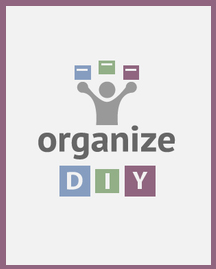 A survey of 45 organizers from six countries — we may speak different languages and live in different time zones, but we’re all seeking answers to the same universal organizing question.
A survey of 45 organizers from six countries — we may speak different languages and live in different time zones, but we’re all seeking answers to the same universal organizing question.
“Pay attention to what sucks in your life. Too often, we spend our days drifting along on autopilot, tolerating things we know darn well we should try to change (or at the very least protest) — and that, more often than not, is what creates so much chaos and frustration in our lives.”
And never let it be said that I’m too good for a shameless plug:
“You must know what’s NOT working to eliminate said irritations. That’s why The A-To-Z Of Getting Organized‘ starts with ‘A is for awareness!'”
Balancing Act — Overcome Overwhelm In A Freaked-Out World

This project exploded into a 106-author collection of overload avoidance strategies. (Oh, the irony.) My tip’s a two-parter — first looking at causes:
“Overwhelm is a state of mind — the worry/dread you experience when you’ve got more on your plate than you can handle. But ironically, a lot of unfinished ‘little stuff’ can cause more stress than one big incompletion.”
Then examining a practical quashing technique:
“Take a minute to write down EVERYTHING that needs done — how many of those to-dos are really minor? Pick a half-dozen little items that can be completed in five minutes each or less (an e-mail to send, a call to make, a website to look up.) Block off 30 minutes to cross these items off your list — you’ll be amazed at how the weight lifts from your shoulders!”
Save
Click here for reuse options!
Copyright 2001 RamonaCreel.com
 PS: Wanna instantly rack up some serious virtual cred? I've made it easy for you to share this content with your social networking friends, e-mail it to your peeps, or republish it in your own blog (thereby showing off how smart you are) with these links.
PS: Wanna instantly rack up some serious virtual cred? I've made it easy for you to share this content with your social networking friends, e-mail it to your peeps, or republish it in your own blog (thereby showing off how smart you are) with these links.
(iCopyright widget here)
"I Have More To Say About This... No Surprise!"
If you would like to reprint this page, please contact me
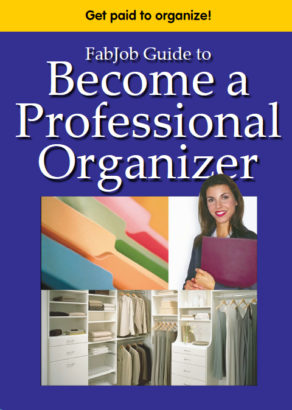






LOVE your website and many blogs. So FUN! Look forward to reading more :-D